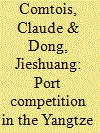| Srl | Item |
| 1 |
ID:
079842


|
|
|
|
|
| Publication |
2007.
|
| Summary/Abstract |
Container ports located in a delta of navigable waterways generally strive to develop the inland river services as a competitive transport mode, with a view to serving local and distant hinterland regions. The spatial and functional development of river-based container networks is location-specific and time-specific. While each barging network and associated seaport system has its own dynamics, similarities in development patterns cannot be excluded. This paper discusses similarities and dissimilarities between the spatial and the functional development of the container river service networks of the Yangtze River and the Rhine River. It is shown that the Yangtze service network has the tendency to converge, in more than one aspect, with the (historical) development pattern of inland container services in the Rhine basin
|
|
|
|
|
|
|
|
|
|
|
|
|
|
|
|
| 2 |
ID:
079841


|
|
|
|
|
| Publication |
2007.
|
| Summary/Abstract |
Asia Pacific economies - particularly Japan, South Korea, China and Singapore - play a large and growing role in the commercial aircraft industry, despite the fact that the region has no major independent plane-maker. Instead, Asia has secured a significant position in the increasingly elaborate global production networks of Boeing and Airbus. The wider Asian significance in those networks has been fostered not only by the region's deep capital and human resource assets but also by the catalytic actions of developmental states in the region. Moreover, decades of rapid air traffic growth have made Asia a crucial market for Boeing and Airbus. In response, the American and European giants have been compelled to outsource more of their business to Asia in order to win sales and to design new airliners tailored to the needs of Asian customers. Together, the increased importance of Asia in both the design and the manufacture of commercial aircraft point to a future in which Asia will capture an ever-larger share of the value created in one of the world's most technologically sophisticated and strategically significant industries
|
|
|
|
|
|
|
|
|
|
|
|
|
|
|
|
| 3 |
ID:
079840


|
|
|
|
|
| Publication |
2007.
|
| Summary/Abstract |
This paper canvasses the port development of the Yangtze River Delta. Initially, we consider changes in container trade in the region since the 1990s. Competition between the ports of Ningbo and Shanghai are studied by measuring the overlapping hinterland of container distribution for Zhejiang province. We then analyse the strategies pursued by international carriers and terminal operators to secure success in this increasingly competitive environment.
|
|
|
|
|
|
|
|
|
|
|
|
|
|
|
|
| 4 |
ID:
079839


|
|
|
|
|
| Publication |
2007.
|
| Summary/Abstract |
This paper examines an exemplary case of 'transnational state entrepreneurship', which was the Singapore government's Suzhou Industrial Park project. Between 1994 and 2001, the Singapore government was directly involved in the development and management of the project, hoping to generate an income that could eventually supplement Singapore's domestic economy. The strategy involved servicing the industrial needs of multinational corporations seeking to locate operations in China. This paper finds that transnational state entrepreneurship was less than successful, as the Singapore government's objectives were only partially achieved. The project's biggest problems were its lack of profitability and, ironically, the state's presence. This led to the Singapore government disengaging from the project in 2001. The paper concludes that it would be very difficult for a state, which is essentially a political entity, to be as efficient as a business entity, especially in an international environment
|
|
|
|
|
|
|
|
|
|
|
|
|
|
|
|